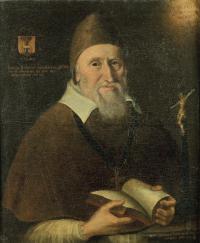The Rothe collection: a legacy of the Counter-Reformation in Ireland
Published in Early Modern History (1500–1700), Features, General, Issue 1(Jan/Feb 2013), Volume 21

David Rothe (1573–1650) was the most important Catholic churchman in Ireland in the seventeenth century. Born into a famous Kilkenny merchant family, David was part of the new trend amongst the Anglo-Irish to seek a Catholic education in mainland Europe. Although it is not clear where he attended school and university, by 1601 he was head of the Irish College at Douai, an offshoot of the English College there. He is portrayed here as a venerable teacher and peacemaker who is ready to meet his creator. (Private collection)
The Rothe collection—on show in last year’s exhibition at Cork’s Crawford Art Gallery, ‘Portraits and People: Art in Seventeenth-Century Ireland’—contains five significant interrelated artefacts. It has intriguing portraits of David Rothe and his nephew, Thomas, painted by some unknown, possibly Continental, artist who was in Kilkenny at the time of the Catholic Confederation. Their dates of 1644 and 1645 may indicate a connection to the presence in the city of the first papal nuncio, Pierfrancesco Scarampi. The books and manuscripts in the assemblage have an emblematic significance that reinforce the same theme.
















